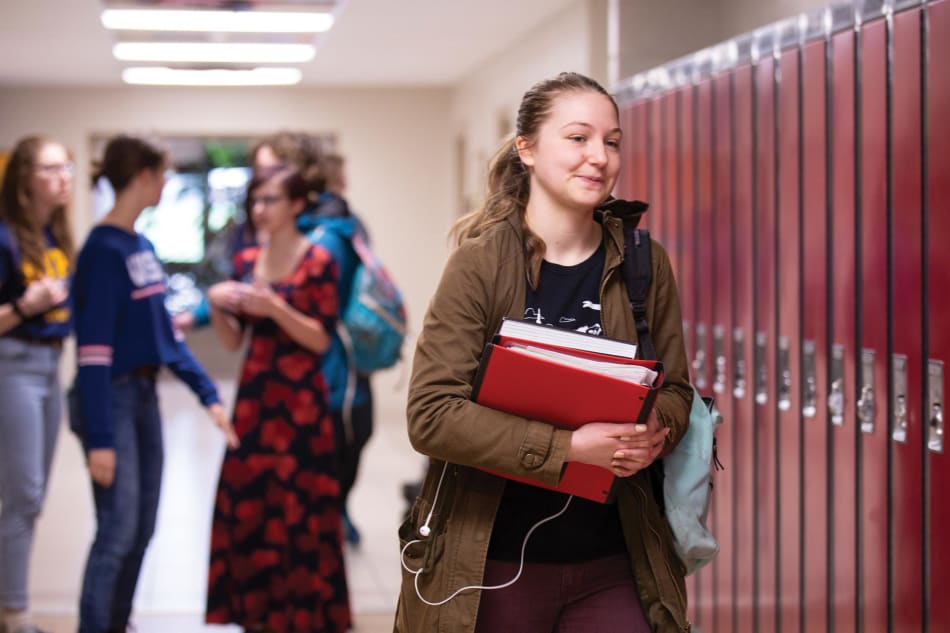Woodland Christian High School THE OUR KIDS REVIEW
The 50-page review of Woodland Christian High School, published as a book (in print and online), is part of our series of in-depth accounts of Canada's leading private schools. Insights were garnered by Our Kids editor visiting the school and interviewing students, parents, faculty and administrators.
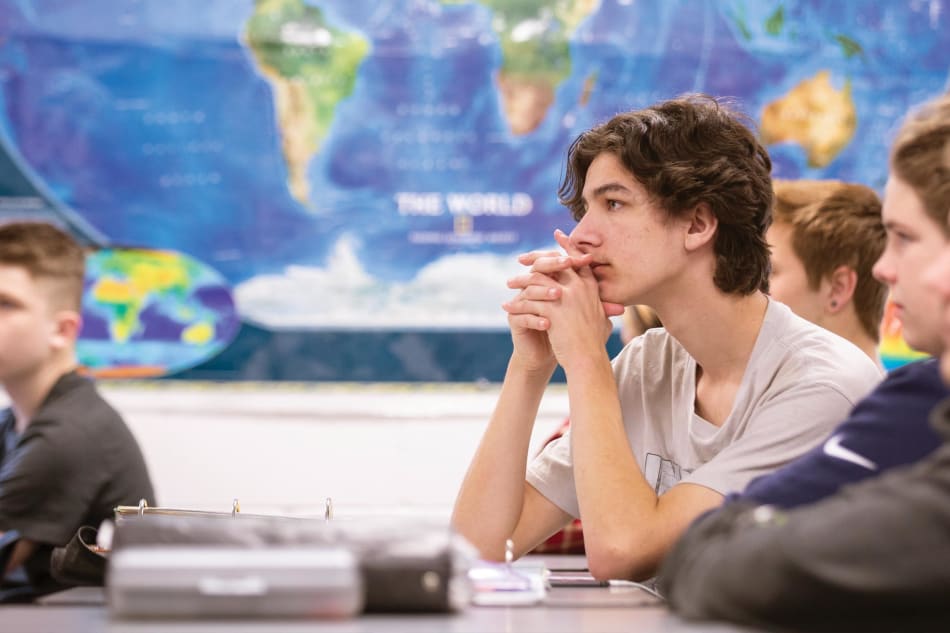
Introduction
“It’s not a Sunday school,” says a student, addressing plainly and frankly the question that attends uniquely to faith-based education: What is it? “The really obnoxious question is ‘are you even a real school,’” says instructor Tasha VanAnkum, “and the extension to that is ‘are you even real teachers.’ For those that are really poorly informed, that’s the starting point.”
Faith-based education can be an elusive concept, given all the various forms that it can take—from Sunday school to seminary—though Woodland Christian High School is a particularly good example of what curricular Christian education can (or should) be. The goal at its founding in 1976 was to provide a quality secondary education—principally for those intending to advance to post-secondary study—that reflects a Christian worldview, where the values of the Christian faith underlie the delivery of the provincial curriculum.
A current student told us that “I see the Christian perspective as an enrichment piece, in that it doesn’t take the place of other things.” Science is science; math is math. At Woodland, it’s less about content, more about perspective and approach, opening up spaces and opportunities that students won’t find in other academic settings. “It allows the students to learn differently,” says Mandy Wiebenga, an English instructor. “There’s a deeper learning that comes from a faith foundation that we can look to and rely on. Everything becomes bigger, more applicable. Everything becomes more significant. It’s not just a book that they have to read for English class—it’s how that book can affect them in the long term.” Says another student, “it’s not just how we learn, but also how we conduct ourselves as a community and how we support each other.”
Ultimately, those are the features that define the Woodland offering: context, community, and support. When students enter the school, they join a community of shared values, rather than a community based in a specific sectarian tradition. Woodland has never been associated with a specific denomination, and since its founding, the school has very intentionally desired to attract students from across denominations, or even outside the faith. Principal John VanPelt estimates that there may be upward of 20 denominations represented across the school, with Pentecostal, Mennonite, Reformed, and Baptist communities most represented in terms of numbers. That diversity is seen as a strength, something that adds depth to the life of the school and veracity to in-class instruction. VanPelt uses the example of the approach to the teaching of origins: “Some of our students will come from a six-day creation understanding. Some of them will come from an intelligent design perspective. Some will come from a progressive evolutionary position. And some just have an evolutionary perspective. There’s a whole range. We will talk about God creating, and about how that happened. There’s room for conversation from there.”
One of the things Woodland certainly isn’t—and this is something that VanPelt and others are keen to address—is a retreat from the world. “I think that sometimes people view Christian education as a way to separate us from the wider population. And while we believe that we’re distinctive from the culture, we don’t want to ever be separate from it.” There are branches in the Christian tradition that have taken the view that the best way to live through one’s faith is by isolating oneself from the broader cultural context. But from its early roots, the opposite approach has been a defining feature at Woodland. Students are energetically encouraged to take part in the culture while living through their faith and their values. “It arises from our understanding that God created this world,” says VanPelt, “and that he calls us to participate in culture, to participate in making culture and in developing culture—[and] sometimes in critiquing culture, but that can’t be limited to simply throwing stones and not participating within it.”
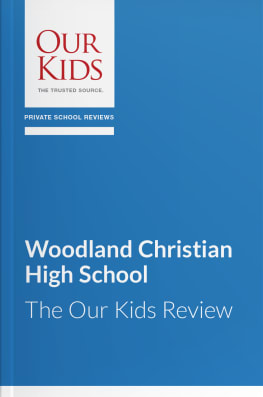
Key words for Woodland Christian High School: Community. Values. Possibility.
Basics
Woodland Christian High School is located in Breslau, Ontario. It offers Grades 9 through 12. There is a sense that Woodland is at a high point in its life, having grown into a size and feel that, at least for much of its early life, was largely an aspiration. There are certainly many things that are very right about what’s happening: from high academic standards to a high level of engagement across the population. There’s a very robust co-curricular program, as well as an athletics program that competes at the very top of Ontario high school competition. The robotics team has ranked highly at the First Robotics World Championships, and the chess club, too, is highly competitive. The arts are very visible—from the instruments being carried off the bus each morning to the plays and concerts—and the music program is well developed, including a concert band, jazz band, and choir. Tellingly, choir and robotics are the two co-curricular programs that students expressed were not compatible with other interests, because both demand a lot of time from those who participate within them.
The DECA program might come third on that list. DECA is a business competition that challenges teams to build business cases and then role play their solutions in front of a panel of judges. The 2019 competition in Toronto drew 8,000 students from across North America. Woodland has had students place in the top 20 at provincials—an impressive feat given that schools are not divided into leagues based on school size.
Further, the moral ecology that exists within the school is distinctive, including the close interaction between the adults, and between students across the grade levels. There’s a sense of shared purpose, and that all are working together in a common understanding of what their personal goals and talents are and how they relate back to the school community.
One thing that makes Woodland distinct in the world of private education, particularly at this level, is that it isn’t intended to be exclusively a preparatory school. When the school was founded, it was a very academic institution, geared for kids who were going to university. That’s still very much the case, though not exclusively. During his tenure as the head of the school, VanPelt has brought in staff who could build the level of support, allowing the school to serve a broader range of learners—and it’s something he’s visibly proud of. While a considerable majority (70%) of students aspire to university, not all do—another 20% of the student body are working toward certificate programs, while the remaining 10% are preparing to enter apprentice programs.
“My personal little soapbox,” says Marjorie Pasma, who provides academic support, “is that a Christian school should be for all students”—not just those intending to advance to university. The full gamut of special needs aren’t supported, perhaps, but there are those who struggle with literacy and numeracy, those who have been diagnosed on the autism spectrum, and those who have physical limitations or mild behavioral issues. Pasma notes that she’d like to broaden the admission parameters even further, though she is cognizant that there are limitations to what Woodland, as a privately funded school, can do. That said, parents are absolutely encouraged to raise any learning difficulties with Pasma and her staff. “We really do try to accept as many as we possibly can,” she says. “We can present to the parents ‘this is what we can offer.’ And the parents can choose whether that’s sufficient and if they feel this is the right place for their student. What we try to do is be very honest about what we have to offer.” Pasma retired in 2019, though that perspective and philosophy nevertheless remains, thanks to the mark she made on the culture in her time at the school.
The school’s aim to serve a broad range of learners is made most plain in the development of the Learning Centre, something that also has grown under VanPelt’s leadership. It’s a space within a highly trafficked area of the building that is used for guidance as well as instruction. It isn’t a space that students visit once or twice a year, but rather one that they visit regularly. It hosts classes in guided learning strategy, where the focus is on the learning skills required for academic success, from organization to goal setting. Sometimes, that takes the form of tutorials using, say, the materials that are being addressed in the English class as the basis for an investigation around how best to approach the content. More broadly, students can also drop in to seek advice or academic support.
What does it mean to provide a Christian-based education?
“I believe that everyone, to some extent, worships something,” says John VanPelt. “They root their values in something, whether that’s themselves, or a religious idea, or humanism. For us, the heart of the Christian worldview is the recognition that Jesus Christ is lord over all of life, and so what we do, how we think, how our values are developed—that all needs to be rooted in what Jesus Christ presents and demonstrates for us.”
The Bible is understandably central to teaching, though VanPelt adds that “we don’t want to approach every issue and open the Bible and say ‘this verse says this.’ I think that’s a limited way of viewing the Bible. But we do want to look at the life of Jesus Christ. We want to look at what Jesus Christ has said, and try to understand our culture in that light.”
“I think that’s fairly basic,” says VanPelt of the approach, and he suspects there are lots of Christian schools that follow a very similar model. “The basic command that we have in the Bible is to love God and to love our neighbour. And that is what we work to make sure is evident in every aspect of the education: Understanding what loving God means, and understanding what loving your neighbour means. That’s throughout the curriculum, and it’s taught through co-curricular programs. It pervades how we approach the discipline of students … it undergirds everything that we do.” The goal is for each graduate to have a strong foundation in character, that they leave the school as “a person with integrity—a person who is what they say they are [and] able to look at the diversity of the world and approach it from the context of a Christian worldview,” while recognizing the great diversity within that context. “We work hard to ensure that all of the different perspectives are appreciated. … It’s critical to us that our learning is rooted in God’s word.”
“When we talk about issues, values, or things that influence the way we operate in this world, we want kids to understand how that relates to their faith. We want kids who will come out of here not with a tone of judgment, but with one of compassion. People who can bring healing and restoration to the communities they are involved in [and] have the tools and the learning that they need to be successful in colleges, universities, workplaces, and beyond.”
Leadership
There are a lot of things that have changed over the years—most obviously through two periods of significant capital development—though continuity of leadership has remained strong and consistent with the founding values. John VanPelt is just the third principal to lead the school since its founding. He knows the previous two principals well, both professionally and personally, and retains close contact with them. He notes that at the 40th anniversary event in 2016, the founding principal enumerated the pillars that the school was created to reflect. In every way, says VanPelt, those pillars remain in evidence throughout the daily operations, and all development refers back to them.
In the 11 years since VanPelt became principal, the student population has nearly doubled, and the facility has been built out to accommodate them and a range of new programs. Says VanPelt, “we’re in conversation with the board, the community, and the various stakeholders, and I would anticipate that we will continue to grow.” He’s notably cautious: growth is not seen as essential, but rather as something that could confer some desirable benefits, including an even broader athletics program and greater diversity within the curricular offerings. That said, there is a desire to keep the closeness, the intimacy, and the relationships of the existing environment: “One of the questions is whether we can maintain the character of the school when we get increasingly bigger.”
VanPelt is himself a graduate of the school, something that notably extends his view of what the school can do, as well as how it can, and should, grow and develop. He speaks in frank, reasoned tones, and he presents as thoughtful, keen to listen, and absolutely approachable—something that staff, students, and parents regularly confirm. “John lets us do our work,” says teacher Harvey Goossen. “He doesn’t micro-manage us … he asks good questions, he’s not afraid to talk to us if there’s something we can be doing different or better—but he gives us a lot of room to do our work and to try new things.”
VanPelt insists that the development of the school over the past decade is less a result of his efforts than it is the work of those he’s brought on staff. That may be true, but of course he’s the one that’s attracted them, the one that maintains and builds the vision for the school. There is a desire to get the right people into key positions and to keep them there, rather than having a lot of movement within administrative roles. Marjorie Sutherland is a prime example of that. She has been with the school for more than two decades, spending most of that time within her current role as vice principal, curriculum. When she arrived, she brought a wealth of experience in education (and particularly Christian education), and continues to be a leader in that regard. She has consistently demonstrated a desire to review and revise best practices in consort with other educators from throughout the region and beyond. For example, she hosts collaborative workshops at various points during the year, bringing together curriculum development administrators from other Christian high schools.
Woodland has long been a member of the Ontario Alliance of Christian Schools, which joined with Edifide and the Ontario Christian School Administrators Association to create Edvance Christian Schools Association in 2018. There has been a sharing of some resources and professional development, including through an annual conference each fall. Historically, the alliance worked together on writing curriculum, which is shared with the members. There is a larger support network—so while the school is independent, it doesn’t exist as an island unto itself. Best practices are shared with other schools, both within the community of Christian schools and those beyond.
The staff and administration is highly visible in the halls throughout the school day, and students clearly find them approachable, which is an important indicator of the health of the environment. “I think that’s critical to our identity as a school,” says VanPelt, and that’s absolutely as it should be.
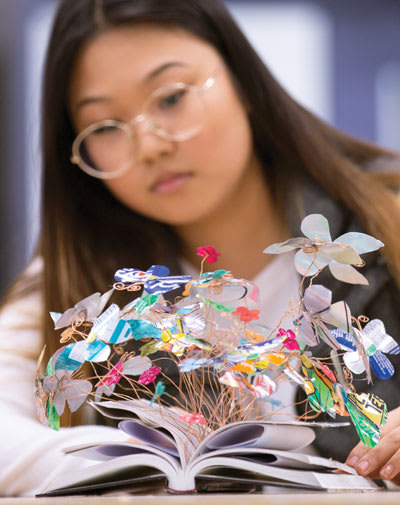
Background
The school began principally as a partnership between Fellowship Baptist and Christian Reformed groups. To some extent they are “odd bedfellows,” admits VanPelt, partially in jest. At that time, there were a number of pastors who were looking to establish a Christian high school, and they knew that the Dutch Christian Reformed community had experience in establishing schools. So, in 1976, they partnered to create Woodland. It first operated out of a series of church facilities. When the current property became available from the Catholic diocese, some members of the school board raised it as a suitable location. They were anticipating urban growth and the development of the highway system, things which would further support the transportation of students to the school (some aspects of which have yet to come to pass). They moved to the site in 1979.
For anyone coming across the property by chance, it may seem that it’s out on its own. “We’re a school in the middle of a corn field,” VanPelt chuckles. It’s funny, though there’s a certain amount of truth to that: the fields rotate between corn and soybeans. Still, the school isn’t here simply because. The property was chosen as a midpoint between the communities that the school serves. It’s viable for families locally as well as those from the northern outlying municipalities, something that is seen as a strength. “We don’t belong to a city,” says Sutherland. “We belong to the collective community. So the Listowel and Drayton folk feel as much ownership here as the Guelph and Kitchener, Waterloo, and Cambridge families.” She adds, “my daughter, who is here in Grade 11, benefits from having friends who come from a completely different home life. Some of our kids literally go home and shovel out the barn, and others live in an ultra-urban, condo-style experience. It’s good for them to mix and mingle, I think.”
That initial partnership between local church communities has remained the defining DNA of the school. Woodland represents a spectrum of Christian faith traditions, rather than focusing on only one. The common tenets are shared, with the bottom line being the Apostles’ Creed. There is also a common belief, expressed to us by parents as well as administrators, that the parents of the school share in educating their children from a Biblical point of view. “If a Christian foundation is going to be transmitted, it comes principally through the parents” and not the school, says VanPelt.
A parent who sits on the parent council commented that, from time to time, someone will raise the idea of bringing in a member of the clergy to serve the school population, though that concept has been consistently voted against. She feels that there is benefit in keeping the roles clearly defined. “We actually talk a fair bit about that, and if we should bring in a preacher. And the feeling [on the board] is that that stuff comes from the family and the churches. It’s not what the school is. It’s a ‘you don’t do our job, we don’t do yours’ kind of thing.” She chuckles, perhaps knowing that that can risk sounding a bit flip. “It’s always a fine line … but you go to your church for Sunday school, and you go to your denomination” for the traditions and the core tenets. “And this is now about putting that into practice while they’re here” at Woodland, where “you’ve got people who you’re working with and they have somewhat similar worldviews, but they’re not identical.” From a Christian Reformed perspective, that stems from the baptism—they make that commitment at birth to raise children within the faith. From the Baptist or Evangelical perspective, it’s part of discipleship, an understanding that scripture commands the faith and is shared and passed along in a practical, active way.
The school today is what it was when it began more than four decades ago: the product of an ongoing partnership between family, faith, and education working together as one. The school works to provide a Christian worldview, woven through the curriculum, that is Biblically based and reflects a Judeo-Christian perspective. The mission and vision of the school, says VanPelt, is to see the students equipped for lives of Christian faith and service. The service is seen as the solidification of the teaching. It happens in every area of student life, from religious instruction to robotics. Throughout, there is a focus on developing all aspects of student life: intellectual, physical, spiritual, and social/emotional.
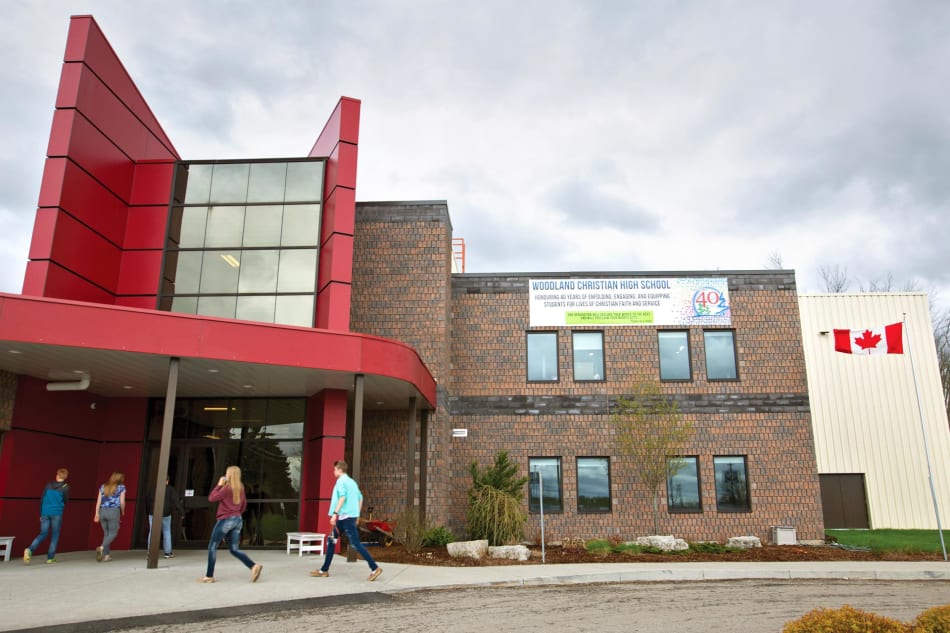
Academics
Woodland offers the Ontario Secondary School Diploma (OSSD) and therefore is required to fulfill the Ontario provincial curriculum outcomes. It’s academically rigorous. A parent told us that “the kids are doing essays and research that I wasn’t doing until university.” She adds that the approach to the content can be demanding as well: “Critical thinking … is the main aspect that I find different” in contrast to her experience with a local public high school. “Maybe the small class size enables that too. Just encouraging them to express their ideas and their opinions and to be able to explain their views and their stances.” She continues, “We’ve had interesting discussions with my kids. My son is not near as—well, I’m not sure if ‘devout’ is the right word—but he’ll really engage with the teachers … they’re discussing things and challenging him, and I think that that’s healthy.” Along similar lines, Sutherland notes that “Sometimes people expect piety, rather than vibrant faith, or that we’re into one-way thinking.” Parents, teachers, and students confirm that’s not the case.
The school doesn’t currently offer the International Baccalaureate (IB), nor does it offer Advanced Placement (AP) courses. That’s not because they haven’t been considered—they have, and Woodland has elected to not offer those programs. AP is waning in importance these days according to an increasing number of curriculum administrators, including Sutherland. The sense is that the AP isn’t the way the world is going, she says, given that it’s exam-based. Places like Georgetown University in Washington, DC, as an example, are very visibly trending toward a portfolio model, rather than ranking by marks alone.
Sutherland notes that the IB has been given more consideration over the years, though so far it hasn’t gotten past the point of a general conversation. It’s perhaps easy to understand why—many schools choose it because of the values piece, which is not something Woodland is lacking in any way. Sutherland, and indeed very many other private school administrators, feel that the Ontario curriculum is rightly very highly regarded, both here and internationally, and is closely accredited. Says Sutherland, “We have to comply, but you also want to comply because it’s good practice.” She also keeps close ties with various associations, including Christian Schools International and Christian Schools Canada: “you really try to stay connected, which is healthy for us.” She also keeps close contact with Christian elementary schools by hosting administrative days and open houses. “We are very much a part of the big puzzle of education in Ontario,” says Wayne Harris, vice principal, student affairs.
The staff is notably youthful in all the best ways. They are also highly qualified—an impressive number of staff members have a masters’ level degree in addition to their teaching degree. They come to Woodland because of what the school represents, and they have a desire to play a role within it. In our conversations, it’s clear that they actively choose to put in the time where it’s due in order to further build and strengthen the offering. The students feel that they are participating in something larger than school, and the staff does as well. Instructors are notably keen to engage in professional development and to seek out conference opportunities, and Sutherland is equally keen to make sure that those kinds of opportunities are acted upon.
One of the instructors VanPelt actively recruited was Stephen Zurakowsky, a professional musician who arrived in 2014. The music program is curricular, meaning that students meet during the instructional day, and band instruction is handled as a class, not as an extracurricular program. That’s partly because, as a busing school, there wasn’t enough time outside of the instructional day to really build anything of merit—but more importantly, it’s because arts are encouraged and therefore have been granted a prominent place within the curricular program.
Music is a very significant part of the life of the school. Between choir and the bands, half the population of the school is active in the music program. That’s a huge percentage of the students in comparison with other schools where music, in most cases, isn’t a class and is otherwise lost within the breadth of sports and co-curricular offerings.
The results are impressive in every way. “You can get a lot of development from the students if you’re playing music all year,” says Zurakowsky, and they do. There’s a Grade 9 class, a Grade 10 class, and a senior Grade 11/12 band class. There’s also a small senior rock ensemble class and a Grade 10/11 guitar class. We asked Zurakowsky how he would quantify the success of the program. He didn’t mention the awards, or the performances, of which there are many. Instead, he says, “Third period today, we had an introduction to some new learning, then playing fun songs, and the students walked out in a really good mood. We were celebrating really good music. I think that’s how I would define success. There’s the other stuff, but what happened today—yeah, that’s what I’m after.” It’s a hard heart that isn’t charmed by that, both the music being made as well as a kind of instruction that leads the students to the joy of music, rather than just the challenges of mastery and performance. They look at the history of the music that they’re playing and also investigate how it relates, or not, to their faith. Zurakowsky adds that the students continue playing after they graduate from the school—it’s something they take with them, many of them for life. “It’s like they’re thriving at that point,” he says, “and the skills they’re learning—being in a community, and in a band—they’re going to bring with them into other fields [of interest]. And that’s what I hope for them.”
Teachers throughout the school display that kind of spark for what they do and what it can bring to the culture of the school. “It all worked out!” says English and humanities instructor Melissa Westervelt of a recent production of the full text of Shakespeare’s A Midsummer Night’s Dream. For her, the gauge of success is both the quality of the performance as well as the community that exists at the end of the project. “We work on it for months on end, multiple times a week. And by the end of it, you have kids, Grades 9 through 12, in their hair and makeup—they’re all ready to go, and they’re sitting in a corner of the room playing cards.” She points out that “in very few other circumstances would you have that” cross-section of the student body coming together, because most large-scale extracurriculars, such as the athletics teams, are separated by gender and by age. “But in the play, you have about 50 members of the cast, and they’re all just hanging out together. There’s so much love and support for each other. And, yes, it’s the excitement of putting on a finished project, but it’s also the way they come together and the way they support each other when they get to that point.”
Accommodation and academic support
Accommodations, consisting of both tutorial support and in-class adaptations, are offered for a range of learning difficulties. There is a guided learning class, and students who can benefit from it attend three times a week. Staff members work with them to expand their use of technology and a range of learning strategies and behaviours. On the day we visited, Pasma was working with a group of students prior to the first class of the day, going over grammar and punctuation points, as well as test-taking strategies in light of an upcoming literacy test. After speaking with us, she met with a student who struggles with reading and had put aside some time to work with her on a history assignment. “Together, we read through a fairly sophisticated piece of writing that he had to read for the class, so that he can then answer the questions that his teacher posed to him about that for his Grade 12 history course.” It was about the beginning of World War II and included a text selection from Czar Nicholas, who gave his rationale to the Russian people about why they were going to war. There was a similar piece from Kaiser Wilhelm and two other world leaders, each expressing the impetus for war in their own words. “We read through them together, and talk about ‘What did he say?’ Going over the vocabulary and then talking about what he was really saying about why they were going to war.” Nearby, an educational assistant worked with a student who required some help with math.
Most students entering academic support will come to the school with individualized education plans (IEPs) in place. In other cases, they will be identified by teachers who will report students to guidance, and a plan will be put in place to address any deficits. The guidance and guided learning suites are both spacious and near each other, something that Pasma notes is intentional. “It’s a good team approach,” she says. “We work hand in hand with teachers and parents. And that seems to be a good approach—when you have a team approach and consider the whole kid,” including social, academic, and behavioural inputs. “We’ll confer with guidance, with parents, to try to figure out what’s going on, what we’re seeing. If there’s a larger issue, we may make a recommendation to parents, and that they may want to have an assessment done.” Otherwise, as with the students Pasma was meeting with that morning, tutorial sessions or guided learning sessions will be planned.
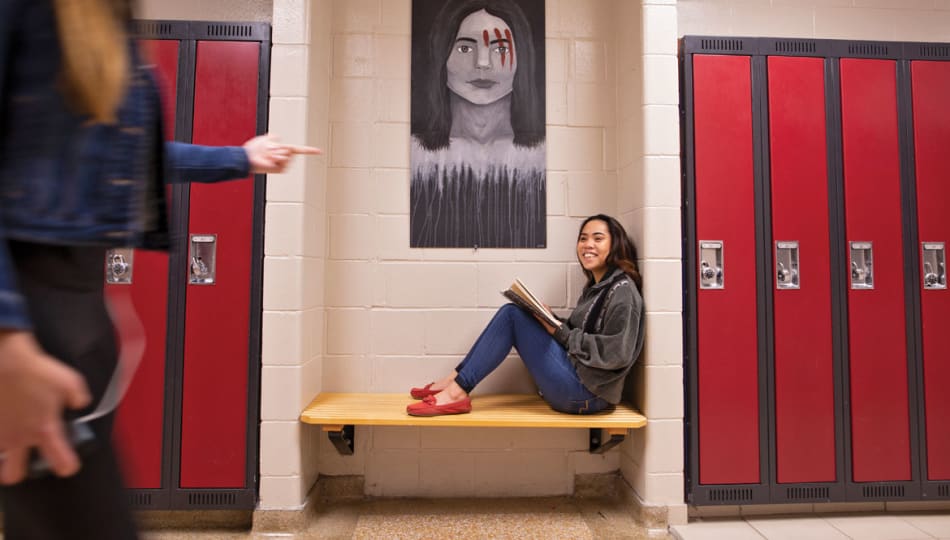
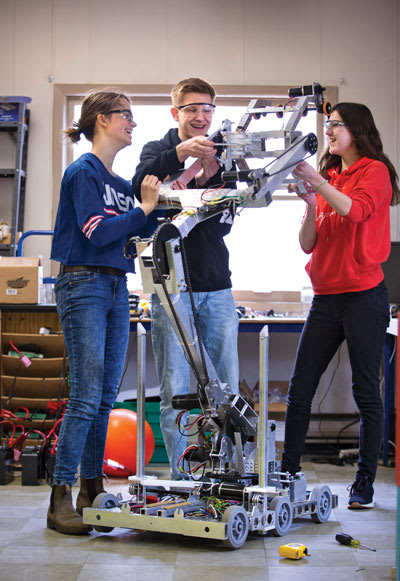
Student life
The student population is 350, up from 200 about a decade ago. That’s a nice place to be—it allows a rich program of extracurricular programming, while also maintaining a small-school, inclusive feel. “It’s hard to fly under the radar,” one student told us.
Students arrive from a very large catchment area, including Kitchener, Cambridge, Waterloo, Guelph, Listowel, Drayton, and Wingham/Palmerston. There are bus routes that service those communities. The longest commute is an hour or so, and transportation is included in tuition.
The student body is notably diverse, something that the staff and administration rightly take pride in. Says VanPelt,
“We will invite and include any kids who come here. We view them as image bearers of God. And, so, as an image bearer of God, they are given dignity, they are given respect, and they are loved and valued in this environment. That’s not dependent on how they act, who they say they are—they are image bearers of God, and so we’re called to love them and welcome them. You will have lots of kids who think and act differently here. Lots of them ask the same questions as they would in any school. As a staff, we’re trying to walk that journey with them. We will continue to hold the Bible as God’s truth. Kids will have questions about that, and our staff will serve as a resource to help guide them without a tone of judgment, but with a tone of invitation to serve God and to discover what that will look like in their lives.”
The diversity within the student population is nicely augmented by the international students. There is a self-imposed 10% cap on international students, which means that in any given year, they won’t account for more than a few dozen students. It’s a nice level that, for the students arriving from overseas, ensures that they have a truly immersive experience. For the students arriving each day from the local communities, it adds perspective. In the 2019/2020 school year, Woodland hosted students from Colombia, Iraq, Taiwan, China, Brazil, Nigeria, and South Korea. Despite its relatively small size, the international program is closely invigilated by Matt Hazenberg, the international student coordinator. For those needing accommodation, he fields and arranges homestays as well as introductions to area churches where students might also find a home. A robust ESL program is offered, though most students arrive with some experience and facility with English (though not all, and there isn’t a test of English as part of the admissions process). The Guided Learning Services department also works closely with international students.
Once on campus, the program of student integration is swift and robust. The first week of school is Niner-fest, and two weeks later the entire grade is out on a camping trip. It’s an excursion that is intended to be absolutely proactive in engaging students within the school community. That continues through the grades, with Grade 10s going to Quebec City for four or five days. Similar trips occur in the upper grades.
It’s important to keep in mind that Woodland’s students are teenagers. In our interactions, they were spunky, outspoken, thoughtful, and academically oriented. A parent commented that “these kids are not necessarily better behaved than kids at other schools. … what is different is that the size of the school means it’s harder for them to get lost, and teachers know what is going on. The feel of the students is one of community. These kids share a greater sense of purpose and clarity for what is important in life.” That said, he adds, “The dynamics of teenagers here is also challenging at times, and this school is not exempt from that. … [Though] these kids are probably more well-rounded than most.”
Not all students are Christian, and that, too, is seen as adding dimension and depth to the offering. One parent told us that “I think that having differing points of view challenges you to take information that comes from outside your point of view. And when that comes from people you know, it is less easy to dismiss it … it requires you to think about it in a more meaningful way.”
The academic day
Days begin at 8:53 (love that specificity!) and end at 3:15. It’s a five-period day, with the exception of Wednesdays, when the periods (including lunch) are bit longer, allowing time for co-curriculars. There are a few after-school programs, including robotics, choir, and some sports, and a late busing program allows students to attend them.
The opportunities for students to take on leadership roles are many and varied. Chapel is on Wednesday every other week, and it’s student led, principally through devotional teams. The student government plays a significant role in the daily life of the school. They lead the assemblies and organize dances, though they also consult on deeper, more lasting aspects of student life. The emphasis is placed on granting leadership practice.
Each day begins with devotions, held within the classrooms rather than together as a school. Usually the teacher—or in the senior classes, a student—will choose a passage from the Bible or other source that has a clear lesson, one that may be related to current events. They’ll read a short passage and talk about it briefly, sharing why they chose it, what it means to them, and why they wanted to share it. After a prayer, they’ll then move to the work of the day. On the day we visited, Pasma led the devotion for the students gathered within the Learning Centre. There had been a shooting and a plane crash in the news, so they talked a bit about those events as well as the need for prayer. This was in response to a student prayer request. Says Pasma, “There’s a lot of stuff going on, so [we’re] just trying to relate what’s going on in our community, in our province [and] globally, and thinking about what that means for us. And thinking about how we can be agents for change or at least be very sensitive to that. If we can’t do anything in particular, we can pray about this.”
Extracurricular programs
In addition to the grade trips every year, there are service trips that go out from time to time, including those to the Dominican Republic. There, students work with orphanages, churches, and hospitals, from physical builds to other forms of service. There’s an optional annual trip that tours battlefields of Europe in France, Belgium, Germany, and the Netherlands. It’s conducted in partnership with Educational Tours and is offered to Grade 12 students.
Choir is an extracurricular, and it’s as intense as it is impressive. It meets Thursdays after school all year round, and the desire to participate is buoyed by the quality of work being done. There are times when students stay as late as 9 p.m., and happily so. The choir goes out many times during the year to participate in services at area churches. They don’t compete in the way that choirs at other schools might, or at least limit themselves to competition. Rather, they share the music they’re making for that purpose alone. A parent commented that “the choir spends an entire day with multiple other choirs learning new music in one day and performing it that evening—incredible!” Certainly, there is a high level of satisfaction with how the program is conducted.
Special Emphasis Week (SEW)
Special Emphasis Week is an annual, student-led initiative where the school picks a charity and mounts activities to raise money in support of it. There’s a range of events, from the silly to the serious. There’s a lunch auction and a dessert auction. The teacher with the most money in their jar at the end of the week gets a pie in the face. The school also invites speakers to come in from the charity organizations to talk about the cause and inform students on issues or injustices other people face. Two years ago, Woodland sponsored an indigenous day camp on Manitoulin Island, which then developed into a new relationship between the school and the camp that’s still ongoing. The events raise upwards of $10,000 each year and are a favourite with parents and students alike.
Athletics
Athletics is an important part of both the curriculum and the life of the school. “Being on teams is an opportunity to find friendship, character,” says Jamie Wright, the director of athletics. “Those are the things that we hope for. I hope that they find opportunities to use the gifts that God has given them and that they find community through athletics.”
Woodland has historically had success in volleyball, though soccer and basketball have grown in recent years, all with teams advancing to the provincial level. Badminton, too, has been a very strong competitive program. The school competes locally in District 8, regionally in the Central Western Ontario Secondary Schools Association (CWOSSA), and provincially in the Ontario Federation of School Athletic Associations (OFSAA).
Wright became director a little more than a decade ago. In the years since, the school population has grown considerably, and the athletic program has grown with it. There are more athletes and more teams. Wright added new sports to the program, including ultimate frisbee seven years ago. He notes that the aim of the athletics program is participation, so cuts are avoided as much as possible. “Some of our teams will make cuts and some of them won’t. Individual sports, like cross-country, are able to field all who wish to compete, and the same is true of some of the teams, including ultimate frisbee and badminton. In volleyball, basketball, and soccer, cuts are more common.”
There is a high level of satisfaction with the athletics program across the school population, thanks in part to the recent successes of the girls’ basketball team. A parent told us that, “My only area for improvement would be to work harder to get the sports and arts extracurriculars to come together so that it’s not as hard for kids to have to choose either/or, but engage in both.” Still, participation rates are very high, with half of the student population involved within the extracurricular athletics program. Given that rates of participation in choir and instrumental music are also well above average, the students are finding a way to make things work, while administration is seeking ways to build in efficiencies, such as the addition of late busing in recent years.

Pastoral care
All students are clearly known and feel comfortable approaching teachers, as our walk through the halls with various members of the staff amply demonstrated. The path to care, either emotional or academic, is initiated by parents, who will approach staff, teachers, and, to a lesser extent, students themselves or their peers.
The size of the school allows for a very close, multi-layered interface between instructors and students. The entire teaching staff meets together every morning from 8:15 to 8:30 a.m. to connect for the day. “I think it puts us all on the same page,” says Nathan Johnson, a member of the guidance department. “It breaks down barriers between departments and spaces within the school,” or otherwise ensures that they don’t form. There are also divisional meetings every Wednesday. Both types of meetings serve as opportunities for teachers to connect and reflect about what they’re seeing in the student population, and they form a cornerstone of the program of care.
There’s a very clear desire to work with the students from where they are. Johnson talks about being aware of the fears unique to teenagers, including the fear of missing out, or of not being amazing—a negative aspect of their culture that can perhaps be laid at the foot of social media. “They may start to do something, and if they feel it’s not going to be amazing, will often stop … or create anxiety in themselves in thinking that they’re not going to be great at the things they value,” Johnson explains. In other settings, the approach might be to limit screen time or cloister devices, while also having workshops on the ills of social media. But Johnson’s approach is more detailed and allows a greater opportunity to deal with the issue head on, rather than simply wishing it to go away. It’s an example, in our discussions with the guidance team, of how they see their role in the many areas of student life.
Academic counselling begins when the students first arrive from Grade 8. The Grade 9 teachers, especially in math, science, and French, track the students with input from the feeder/partner schools (in most cases through meetings at the school). Progress is monitored based on their input. Many students report having mentor-style relationships with at least one member of the faculty, and they also feel very close to the guidance department. Harvey Goossen, a senior guidance staff and instructor, comes up regularly and very favourably in discussions with students. Says Goossen, “We’re a high school. We’re teaching kids. And not everyone is walking through life with the perfect home life, with the perfect church life, and the perfect youth group. I think some people think, ‘you’re at private school, things must be so much easier.’ But kids are kids. They’re walking through some challenging years, and we [as a school population] have the same challenges that other high schools have. I think we have the freedom and the privilege to get at some of those hard truths a little bit more comprehensively, and the privilege to do that from a Biblical worldview.”
Wayne Harris, vice principal of student affairs, describes his work as that of dealing with students who are pushing the boundaries or breaking communal norms. “We always assume that we are teaching teenagers here.” They come from a variety of homes and communities, but they confront the same issues that every other teenager confronts. The program of care begins, rightly, at that point. It is understood that the profession is to teach and discipline real kids working through an important phase of their lives.
Part of what informs the approach to discipline is that the school isn’t simply a school, but it is also a Christian community. Harris notes that when dealing with the harder issues that arise, that’s in the back of his mind: that part of being a Christian community means dealing empathetically and inclusively with all members. “I despise the idea that we ever say to a 16-year-old that you can no longer be with us.” The approach is to allow students the right to make a mistake, the right to get things wrong from time to time—though that right is countered by the responsibility to make things right and to allow them an opportunity to make better choices. Harris says that it’s a graduated process toward holding kids accountable.
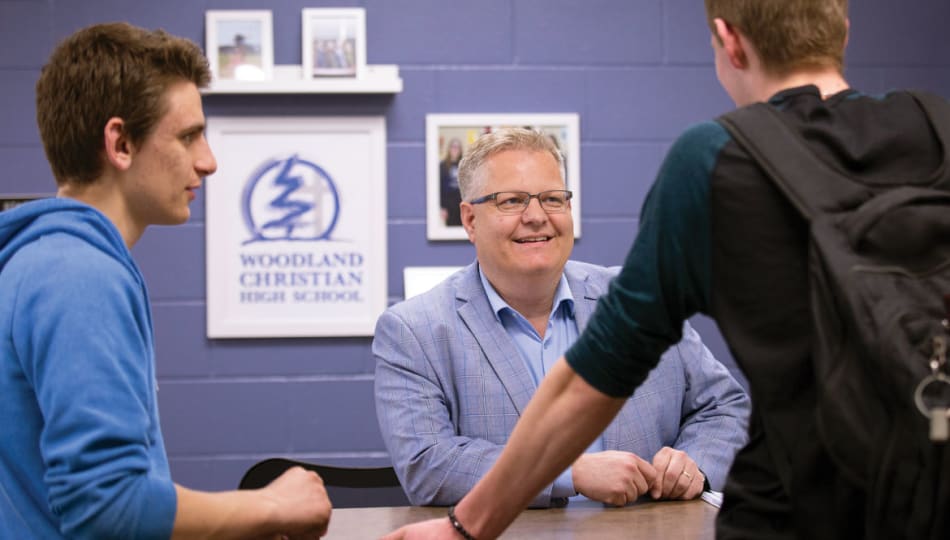
Admissions and tuition
“It’s a comfortable school to enter,” a parent told us. “We felt really comfortable to ask questions.” Visits to the school are recommended, particularly to meet the administration and instructors, who, in our experience, all present exceptionally well. Open houses are held at key times of the year. Attending musical events—such as the Shred band nights or school plays—provides a unique, and perhaps surprising, window into the culture and life of the school.
While some Christian schools require all students to have been baptized into the faith or to come from Christian homes, Woodland doesn’t, and there is open enrolment. “I have kids here who are not Christian,” says VanPelt. “Everyone is welcomed, valued, and appreciated in this context.”
The tuition is very reasonable for a school of this size and scope. That’s especially true given that textbooks and most curriculum-related field trips are included within tuition. Transportation is covered as well, and almost all students take advantage of the busing program. There is both needs-based and merit-based financial assistance available. The needs-based disbursements are intended to ease the cost of tuition, and they average between 10% and 20% of the cost of annual tuition. The Involved Parent Network hosts a number of fundraising events through the year to increase the school’s revenues and, in part, to offset the cost of tuition. Because Woodland is a faith-based institution, the school is also a registered charity, meaning that some tax efficiencies for portions of the tuition may be available.
Parents
A parent of two students told us that “the benefit or the beauty of this school is [the] relationship between students and teachers, and the foundation of that relationship comes not just from wanting excellence in academics, but even more important, it’s a foundation in terms of knowing how to relate to other people. It’s such a cohesive community … I just feel such a confidence in how they’re able to relate to their teachers and others.”
The connection with the parent community is strong. Because of the nature of the offering, parents are clearly invested in what happens within the school, often in ways that aren’t as common elsewhere. Parent feedback is clearly valued and consistently acted upon. “They talk with students, with parents,” a current parent says of the staff. “They have responded when we have asked questions, and they generally seem to view the school as more than just a place of employment, but rather a place of community with the students.”
Families are asked to contribute 20 volunteer hours each year, something that parents don’t find onerous. The ones we spoke with felt that it was a nice opportunity to get out and feel more integrated within the school life.
The takeaway
Paul Branan, director of advancement and development, notes to incoming families that “You’re not buying a product, you’re joining a community.” The staff, at all levels, second that thought. The position of the school is to be rooted in an understanding of God, for the students to understand what it means to love their neighbours, and to encourage them to bring that understanding to bear in their studies, their personal lives, and their work. The quality of teaching is high, with an overt emphasis on excellence. There’s a vibrant academic community, a vibrant arts community, and a vibrant, youthful school culture. The curricular content isn’t significantly different than you’d find in other settings, but it’s delivered within a distinct context—something that, for the families that attend, is a primary draw. “We’re more than just education,” says English and humanities teacher Melissa Westervelt. “We’re community; we’re relationship. [We’re] not only foundational in terms of instruction, but foundational in terms of life, and understanding what life means and how we move forward from here. We’re not just here for academics. We’re here for much more than that.”
There’s a distinct moral ecology built upon a defined, understandable, shared experience of moral order. Kids are encouraged to be themselves and to develop their voices. There’s value placed on both the self and on selflessness, on confidence and humility. It’s a place where character isn’t defined as workplace traits such as grit, resilience, and self-discipline but also as love, service, and care—the traits that are the glue of community and, ultimately, happiness, connection, and purpose. Theologian Lisa Fullam writes that “humility is a virtue of self-understanding in context, acquired by the practice of other centeredness.” The school educates students how to be successful and gives them all the tools they’ll need, but it also teaches them why: to serve and to deploy their talents and time in ethical pursuit, in that “other centeredness.”
“I think parents come with a desire for strong academics,” says teacher Scott Stevens, “but after they leave, they’ll say, ‘my kid felt valued here, and known. They weren’t just a face in the hall.’” Adds Mandy Wiebenga of the student experience, “It’s very personal, and I think parents are continually surprised at how well their child was known. And it wasn’t about how well you did on that one test that one time—it was about who you were while you were here.”
Families aren’t drawn by a specific sectarian tradition, because the school doesn’t reflect one. Rather, they are drawn by values, community, and education situated within a context of purpose and meaning, one informed by an understanding of life lived in a shared faith. “They come for all kinds of reasons,” says VanPelt of the families who turn to Woodland. “Our mission is to equip students for a life of Christian faith and service, which is not inward looking. It’s outward looking. They need tools, knowledge, understanding, and wisdom.” The guiding principle of his work, he feels, is to continually ask “what can we do to equip them?” Marjorie Sutherland adds, “I really hope that kids leave with a sense of self, a confidence that they’ve been given a set of God-given gifts … that those are valuable things for them, and that other people want to receive what they have to give.”
